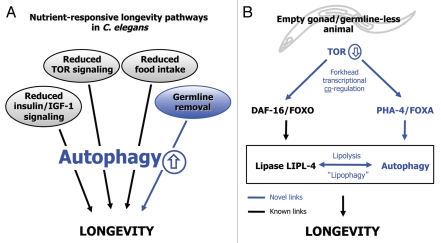Figure 1.
Role of autophagy in nutrient-sensitive longevity pathways in the nematode C. elegans. (A) Multiple conserved longevity pathways extend life span in C. elegans by upregulating autophagy. Highlighted in blue is the germline signaling pathway, in which removal of germline stem cells extends the life span of adult worms. Germline loss can be achieved by laser ablation of germline precursor cells in the worm larvae, or by genetic mutation. (B) Model of the mechanism by the germline signaling pathway extends life span in C. elegans by coordinately regulating LIPL-4-mediated lipolysis and autophagy. These processes are likely regulated by the common upstream regulator TOR through the forkhead transcription factors DAF-16/FoxO and PHA/FoxA. These two transcription factors regulate lipid metabolism and autophagy, respectively. This model is modified from Lapierre et al., Curr Biol 2011.

